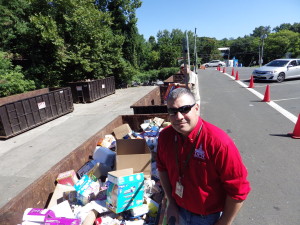The sweet smell of success
On Nov. 3, 1997, Greenwich blasted its twin smokestacks at the Holly Hill waste disposal facility creating a stark line of demarcation between the old way of dealing with trash and today”™s sort ”™em and sell ”™em ethos.
The 14-acre site, according to anecdotes from multigenerational carters, had been accepting trash since the 1890s. Trash in those days was largely organic and certainly on a one-way trip to oblivion.
The waste that arrives today could be said to be merely visiting on its way to other fates: either recycled to live again or ”” modern oblivion ”” burned in waste-to-energy plants in Bridgeport and Peekskill, N.Y.

The town switched to so-called “single stream” recycling in 2011, modeling its program on an existing Stamford program. “In two years, we”™ve seen a dramatic increase in the amount of material people recycle,” said John J. McKee, superintendant of the town”™s Waste Disposal Division of its Department of Public Works. “Our goal is to reduce, reuse and recycle; nothing is kept on site. Reduction by any means is the goal ”” if it has to come here, let”™s recycle it.”
Single stream (unseparated) recyclable material brings Greenwich $17.50 per ton. In 2012, that added up to $230,000 in black ink. The estimate for this year is $234,000. That translates to some 13,900 tons per year recycled.
And because so much is recycled, the town was able to cancel the contract that formerly hauled pre-single stream garbage for $800,000. McKee cited the total cost-avoidance to taxpayers across just two years at $1.27 million.
It will still cost taxpayers $6.24 million to run the facility this year.
It costs $87.60 per ton to cart away the garbage that has no value ”” the likes of food- and chemical-contaminated products, stuffed toys, old basketballs and unuseable textiles.
The average citizen who throws out a plastic binder can do his or her wallet a small favor by breaking it down into its component parts: plastic cover, cardboard liner and metal rings. The binder, therefore, costs the taxpayer money whole, but has value if separated.
Mixed metals bring the town $70.50 per ton and they contributed $6,250 to Greenwich coffers last year.
Construction and demolition debris is an entrenched waste problem, chock full of concrete, glass, metal, polyvinyl chloride and insulation. The town now pays $78.18 per ton to get rid of it. But that debris can experience serious weight loss if the dirt, gravel and stone are removed. The town has begun screening such debris; the separated dirt and rock cost Greenwich $48 ton to dispose of.

McKee said the $1.27 million in cost-avoidance savings is abetted by the diversion of 75 percent of the waste stream toward recycling (and 25 percent toward the incinerators). Before single-stream recycling began and the town urged a shift from blue buckets to 35-gallon recycling containers, those numbers were reversed: 25 percent recycled and 75 percent fated to the garbage equivalent of one-and-done.
McKee presents a study in positive municipal attitude, fielding questions on the phone and explaining ”” one suspects for the umpteenth time ”” the ins and outs of the facility. “This is accepted. That is not. You must be a town resident …” His emails feature a quote from Shakespeare”™s “Henry V.”
Six employees ride herd on as many as 1,100 drop-offs per day, including Assistant Superintendent Patrick B. Collins, waste separators Dexter Gittens and Billy Lawlor, and machine operator John Boraski, who navigated a diesel front-end loader around another Holly Hill effort: blacktop that was formerly road surface, peeled up, ground up and stacked in a mid-site mountain for future paving projects. Anthony Rhaney runs the scales.
Ten years ago, the town shipped 50,000 tons of trash to be burned or buried. Before single stream began two years ago, that number was 43,821 tons. Now it is 35,752 tons.
“The more we can divert from the high costs of municipal solid waste disposal, the better off we are,” McKee said.